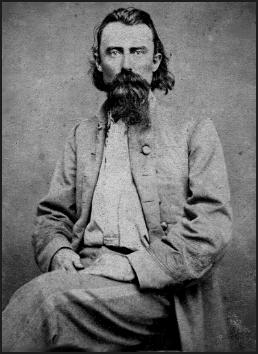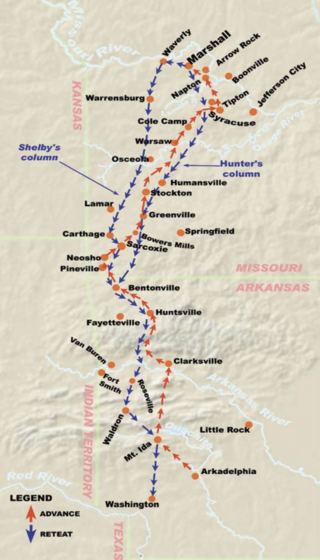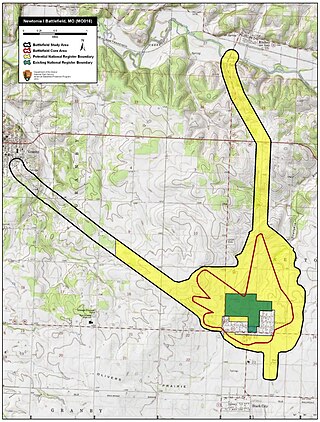The following Missouri units and commanders fought in the Battle of Carthage of the American Civil War. The Union order of battle is listed separately.
MG Sterling Price [not present]
Governor Claiborne F. Jackson
Col Lewis Henry Little, Adjutant General
| Division | Regiments and Other |
|---|---|
| Third Division |
|
| Fourth Division |
|
| Sixth Division |
|
| Eighth Division |
|
Note: Several independent cavalry units were attached to Rains' Eighth Division. Among these a contingent of 150 mounted troops under the command of Capt. Jo Shelby distinguished themselves on the vanguard of the Southern action throughout the battle. From daring battlefield maneuvers under fire by Sigel's batteries to pressing Sigel's retreat to Sarcoxie, Shelby's cavalry "snatched the victory at Carthage from Sigel's grasp." Altogether, the Missouri State Guard included over 2,000 unarmed men who did not participate in the battle.

The Battle of Pea Ridge, also known as the Battle of Elkhorn Tavern, took place during the American Civil War near Leetown, northeast of Fayetteville, Arkansas. Federal forces, led by Brig. Gen. Samuel R. Curtis, moved south from central Missouri, driving Confederate forces into northwestern Arkansas. Maj. Gen. Earl Van Dorn had launched a Confederate counteroffensive, hoping to recapture northern Arkansas and Missouri. Confederate forces met at Bentonville and became the most substantial Rebel force, by way of guns and men, to assemble in the Trans-Mississippi. Against the odds, Curtis held off the Confederate attack on the first day and drove Van Dorn's force off the battlefield on the second. By defeating the Confederates, the Union forces established Federal control of most of Missouri and northern Arkansas.

The Battle of Wilson's Creek, also known as the Battle of Oak Hills, was the first major battle of the Trans-Mississippi Theater of the American Civil War. It was fought on August 10, 1861, near Springfield, Missouri.

The Battle of Westport, sometimes referred to as the "Gettysburg of the West", was fought on October 23, 1864, in modern Kansas City, Missouri, during the American Civil War. Union forces under Major General Samuel R. Curtis decisively defeated an outnumbered Confederate force under Major General Sterling Price. This engagement was the turning point of Price's Missouri Expedition, forcing his army to retreat. The battle ended the last major Confederate offensive west of the Mississippi River, and for the remainder of the war the United States Army maintained solid control over most of Missouri. This battle was one of the largest to be fought west of the Mississippi River, with over 30,000 men engaged.
The Army of the Southwest was a Union Army that served in the Trans-Mississippi Theater during the American Civil War. This force was also known as the Army of Southwest Missouri.
The Army of the Border was a Union army during the American Civil War. It was created from units in the Department of Kansas to oppose Sterling Price's Raid in 1864. Samuel R. Curtis was in command of the army throughout its duration.

The Battle of Carthage, also known as the Engagement near Carthage, took place at the beginning of the American Civil War on July 5, 1861, near Carthage, Missouri. The experienced Colonel Franz Sigel commanded 1,100 Federal soldiers intent on keeping Missouri within the Union. The Missouri State Guard was commanded by Governor Claiborne F. Jackson himself and numbered over 4,000 soldiers led by a hero of Mexico, Sterling Price, along with 2,000 unarmed troops who did not participate in the battle.
The Battle of Hartville was fought January 9–11, 1863, in Wright County, Missouri, as part of John S. Marmaduke's first expedition into Missouri, during the American Civil War.

Joseph Orville "J.O." Shelby was a senior officer of the Confederate States Army who commanded cavalry in the Trans-Mississippi Theater of the American Civil War. After the Confederacy surrendered, Shelby tried to swear fealty to Emperor Maximilian I during the French invasion of Mexico. With the Emperor's permission, Shelby formed a colony of Confederate exiles in Mexico until the defeat of the French, then abandoned the operation.
These are the units and commanders who fought for the Confederacy in the Battle of Pea Ridge. The Pea Ridge Union order of battle is shown separately.
The following Union Army units and commanders fought in the Second Battle of Bull Run, also known as the Second Battle of Manassas, of the American Civil War. The Confederate order of battle is listed separately. Order of battle compiled from the army organization during the battle, the casualty returns and the reports.

Shelby's Raid, also known as Shelby's Great Raid, was a Confederate cavalry incursion into Arkansas and Missouri during the American Civil War in 1863. Led by Colonel Joseph Orville Shelby, the raid took place from August 21, 1863, to November 3, 1863, covering over 800 miles across territories in west central and northwest Arkansas, as well as southwest and west central Missouri.

Shelby's Iron Brigade, also known as the Missouri Iron Brigade, was a Confederate cavalry brigade, led by Brigadier General Joseph O. Shelby, in the Trans-Mississippi Theater of the American Civil War.
Of the brigades listed below, only Philips' and Benteen's brigades, and a small part of Sanborn's brigade from the Union Army of the Border fought in the Battle of Mine Creek of the American Civil War. The Confederate order of battle is listed separately. The entire organization of the Army of the Border is shown.
The following Union Army units and commanders fought in the Battle of Carthage of the American Civil War. The Confederate order of battle is listed separately.
The 46th Arkansas Infantry (Mounted) (1864–1865) was a Confederate Army Mounted Infantry regiment during the American Civil War. While authorized by the State Military Board as an infantry regiment, the unit was mounted for Price's Missouri Expedition and served as mounted infantry. Due to its mounted status, the unit is sometimes referred to as the 46th Arkansas Cavalry when a numerical designation is used. The unit is almost always referred to as either Coleman's Arkansas Cavalry Regiment or Crabtree's Cavalry in official reports from the period.
The 44th Arkansas Infantry (Mounted) (1864–1865) was a Confederate Army Mounted Infantry regiment during the American Civil War. While authorized by the State Military Board as an infantry regiment, the unit was mounted for Price's Missouri Expedition and was officially designated as mounted infantry, but this designation was almost never used by the unit. When a numerical designation is used, the unit is sometimes referred to as the 29th Arkansas Cavalry Regiment. The unit is most often referred as McGehee's Arkansas Cavalry Regiment for its commander, James H. McGehee. McGehee is often spelled McGhee in the Official Records of the Union and Confederate Armies.
The 5th Missouri Infantry Regiment evolved from a network of several unofficial pro-Unionist militia groups formed semi-secretly in St. Louis in the early months of 1861 by Congressman Francis Preston Blair, Jr. and other Unionist activists. The Fifth Missouri was largely composed of ethnic Germans, who were generally opposed to slavery and strongly supportive of the Unionist cause. Although initially without any official standing, beginning on April 22, 1861, the militia regiments Blair helped organize were sworn into Federal service at the St. Louis Arsenal by Captain John Schofield acting on the authority of President Lincoln.
Benjamin Franklin Gordon, commonly known as B. Frank Gordon, was a Confederate States Army colonel during the American Civil War. Gordon had been a private and bugler for a Missouri regiment serving in the U.S. Army during the Mexican–American War. Gordon served in the Confederate Army under Brigadier General Joseph O. "Jo" Shelby in Missouri and Arkansas in the Confederate Trans-Mississippi Department throughout the war. On May 16, 1865, with the war coming to an end, General E. Kirby Smith, as the Confederate commander of the Trans-Mississippi Department, assigned Gordon to duty as a brigadier general. The Confederate government took no action on the appointment and Confederate President Jefferson Davis did not officially appoint and nominate Gordon to the rank of brigadier general because the Confederate Senate last met on March 18, 1865, and Davis was captured by Union troops on May 10, 1865. Although he was only aged 40 at his death, Gordon survived the war by little more than a year.

The First Battle of Newtonia Historic District, near Newtonia, Missouri, is a National Register of Historic Places (NRHP) site that preserves the location of the First Battle of Newtonia, an 1862 battle during the American Civil War. The battle saw Confederate troops under Colonels Douglas H. Cooper and Joseph O. Shelby defeat a Union force commanded by Brigadier General Frederick Salomon. The historic district contains some Civil War-period structures, as well as the Mathew H. Ritchey House, which is listed separately on the NRHP.
Ebenezer "Ben" Magoffin (1817-1865) was a Confederate officer in the American Civil War who carried a Missouri State Guard's colonel's commission and became a prominent figure in the early phase of the war in Missouri. He was sentenced to death by a Union Army military commission in 1862, but was spared execution after Kentucky Governor Beriah Magoffin pleaded for the life of his brother with Abraham Lincoln.